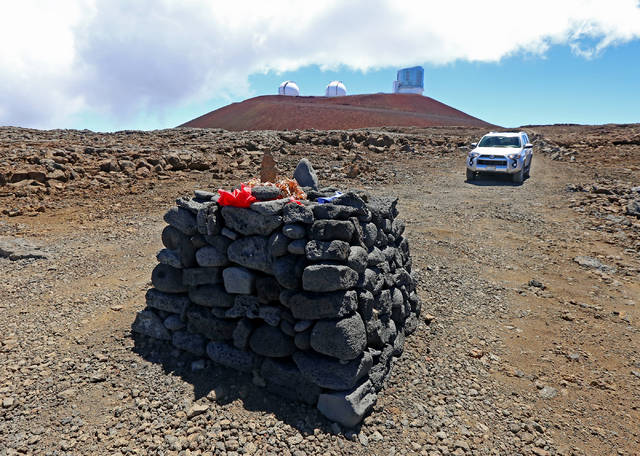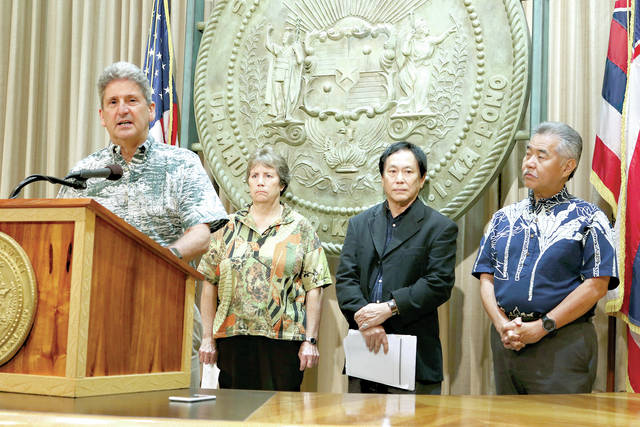Hawaii Supreme Court gives telescope green light, while opponents consider next move


University of Hawaii President David Lassner, left, speaks at a news conference on Tuesday in Honolulu accompanied by state Board of Land and Natural Resources Chairwoman Suzanne Case, second from left, Attorney General Russell Suzuki, second from right, and Hawaii Gov. David Ige, right, regarding a Hawaii Supreme Court ruling upholding a decision to grant a permit for the construction of the Thirty Meter Telescope on Mauna Kea. The state Supreme Court’s 4-1 ruling is a victory for the contentious Thirty Meter Telescope planned for Hawaii’s tallest mountain. (AP Photo/Audrey McAvoy)
HILO — After facing years of setbacks from protests and legal challenges, the Thirty Meter Telescope cleared its last major hurdle Tuesday before the Hawaii Supreme Court.
HILO — After facing years of setbacks from protests and legal challenges, the Thirty Meter Telescope cleared its last major hurdle Tuesday before the Hawaii Supreme Court.
The judges ruled 4-1 to affirm the approval of the project’s Conservation District Use Permit by the state Board of Land and Natural Resources, after previously ruling against the agency nearly three years ago because of due process issues.
Thayne Currie, a Maunakea astronomer and TMT supporter, said the project has been worth the wait, and he thinks the court applied the “letter of the law” in both decisions.
“We are excited and ecstatic about what the future may hold for the island and for the ability of the island to be a place where we discover more about the universe,” he said.
TMT International Observatory had selected a backup site in the Canary Islands in case it can’t build the next-generation observatory on Maunakea. While no announcement has been made about when construction could resume, Henry Yang, TIO board chairman, said in a statement the organization is “excited to move forward in Hawaii.”
“We remain committed to being good stewards of the mountain and inclusive of the Hawaiian community,” Yang said. “We will honor the culture of the islands and its people and do our part to contribute to this future through our ongoing support of education and Hawaii Island’s young people.”
The 180-foot observatory is slated to be built at the 13,100-foot elevation below the mountain’s summit. The court upheld the project’s sublease with the University of Hawaii earlier this year.
Some Native Hawaiians consider the mountain sacred, and the project has faced opposition from Hawaiians and environmentalists who say Maunakea is already overbuilt or that it will interfere with cultural and religious practices. Protesters interrupted the groundbreaking in 2014 and construction in 2015 by blocking the Maunakea Access Road.
While acknowledging that the construction of telescopes on the mountain, seen as one of the best places in the world for astronomy, has caused significant cumulative impacts to cultural resources, the court found mitigation efforts to be satisfactory.
Those include removal of five telescopes, removal of the Poliahu Road and lease payments that will help fund conservation efforts. TIO also is paying $1 million a year to fund educational programs on Hawaii Island.
The ruling supported the Land Board’s conclusion that the project won’t interfere with cultural or religious practices at the summit or Lake Waiau, and that there are no ahu or other cultural resources on the project site, prior to two being built by protesters. The justices noted that cultural practices and astronomy have been able to coexist.
Kealoha Pisciotta, an appellant who uses the mountain for religious practices, disagreed with those findings, and she doesn’t think the ruling will settle the issue.
“The long and the short of it is this now opens all Conservation Districts to development,” said Pisciotta, who characterized the ruling as “extreme.”
She said no decision had been made about whether to appeal the ruling to the U.S. Supreme Court, but she didn’t rule out additional legal measures or protests on the mountain. Pisciotta said decisions will be made as a group, and she asked others to “stay in aloha, and don’t give up.”
“I think what we’ll see is great change,” she said. “Because in the end, reality is what we all agree to. I don’t think people are going to see this as just.”
KAHEA: The Hawaiian-Environmental Alliance, one of the contested case participants, said on Facebook that the ruling “wrongly relies on representations that there is ‘no evidence’ of Hawaiian cultural practices. … Thousands of Hawaiian cultural practitioners have affirmed the sacredness of the entirety of Mauna Kea.”
Opponents have 10 days from the ruling to ask for reconsideration and 10 days from final judgment to appeal to the U.S. Supreme Court. The final judgment will occur after the dissenting opinion is published.
The dissenting opinion had not been published by press time.
Following the favorable ruling, Currie said TMT supporters will take everything “one step at a time” and that they will continue to reach out to those who disagree with building the telescope on Maunakea.
“To those who oppose the project, we respect you, and we want to find a way forward,” he said.
Scott Ishikawa, a spokesman for TIO, said the next step for the organization is to submit a construction plan. He couldn’t say when construction would resume. The Canary Islands remains a backup site, though TIO plans to move forward in Hawaii.
If construction resumed in 2019, the project could be complete in 2029, Ishikawa said.
Gov. David Ige said during a press conference that he respects the right of opponents to protest the project peacefully, but added he will ensure the project can proceed following the ruling.
Asked if that means he would bring in the Hawaii National Guard if needed, he said, “I am committed to assuring the right of the project and of the permittee to proceed … is enforceable, whatever that means.”
Ishikawa said TIO also respects the rights of protesters, but it expects the county and state to provide “safe passage for our workers.” During protests three years ago, construction workers were repeatedly blocked from ascending the mountain.
While the ruling likely won’t settle the debate over how the mountain should be managed, he said, “I think the lesson out of all this debate is TMT realizes it is special, Maunakea is special, and we promise to be the best stewards to help care of her.”
The partners for the $1.4 billion project selected Maunakea as the proposed site in 2008.
The current partners are Japan, China, India and Canada, in addition to the University of California and Caltech.
Email Tom Callis at tcallis@hawaiitribune-herald.com.



$1.4 Billion to stare into space, built in a county that has 20% of households on EBT.
Right, so let’s scrap all human progress, no more space program, eliminate all corporate R&D and give it to people who don’t even have the energy to get a job. There’s some precedent, it’s been calculated that if all the money spent on Great Society programs had simply been given to the poor, they no longer would have been . . . poor. The problem is that wouldn’t have worked, if you just give people money, they burn it. People have to work their way out of poverty or they never will.
Exactly Poutwest…that way we can get 60% on EBT and keep them voting Democrats into office for more taxation.
Well said!!!!
Many if not most of the people protesting this were on EBT. Now that it looks like the economy on the Big Island may start up again someone should go chronicle all of the able body people on the dole it is an easy assignment just go to KTA on EBT day. If you work for cash, have free healthcare, subsidized housing, and EBT it is a pretty good life and this is exactly the life many politicians encourage. Let’s put these guys to work.
BTW there are lots of practical applications for Space and Optical Science which astronomy is a big part of. fiber optics are the backbone of the internet, satellites bring us world wide communication and intelligence. Also the next war will probably be fought in space and as anyone that has lost a war will tell you that changes everything.
I saw a guy panhandling on Henry street the other day, this dude was ripped, obviously physically active. There’s no reason he couldn’t put on the bright yellow t-shirt and go to work, like plenty of other able-bodied young men do every day.
Lost a war? Yeah the Hawai’ians know all about that. We haoles stole their land and you know it!
Yes I think that is right, but the Tahitians killed the original native Hawaiians and stole the land from them. We should all hope that the United States never looses a war or this is what happens.
Anyway is the songs goes..
You’ve got to know when to hold ’em
Know when to fold ’em
Know when to walk away
And know when to run
Hopefully it will create jobs to get a few of the people off EBT…other jobs than on the mountain…
Funny that if the sovereignty fringers would have won they would be claiming that “justice was done!”
Now that they have lost will say, “it doesn’t matter because it is the fake State of Hawaii”.
This now paves the way for Eoff to build her rentals up there!
Good one!!
With a 4 to 1 ruling the opponents don’t appear to have a snowballs chance in Kona to prevail at the US supreme court. Prepare for more temper tantrums and lawlessness from this crowd, its all they know.
Kealoha Pisciotta said “no decision had been made about whether to appeal the ruling to the U.S. Supreme Court” – This is exactly why you want a rational supreme court in place, to stop the nonsense.
Have no fear – the “flat earth society” anti TMT crowd will continue to oppose any scientific progress. How else are we going to subvert the rule of law and continue worshiping piles of rocks or extort payments form the “white devil”?
I wonder why opponents don’t see the possibility that a telescope that could help all of mankind might just be the best use of a sacred mountaintop?
The anti tmt crowd can join Hillary in crying since they lost. Why don’t they get a job and quit riding welfare?